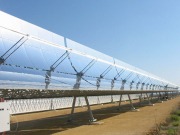
The NREL report found that, compared to solar PV, CSP having a six-hour storage capacity can lower peak net loads even when the sun isn’t shining, thereby adding at least $35.80 per megawatt hour to the capacity and operational value of the utility. This value increases when compared to CSP without energy storage.
The additional value is a result of the ability of thermal storage with CSP to displace expensive gas-fired generation during peak loads, rather than displacing coal, and also because it can continue to flatten the peak load during the evenings when PV isn’t contributing to the energy mix. The report noted that the $35.80 per MWh value would be a result of a situation in which there is a relatively high penetration of renewables into the utility mix, say about 34%. Any lower than this and the value would be less.
The authors, Paul Denholm and Marissa Hummon, simulated grid operations in two balancing areas in Colorado and the NREL is using the same approach in California with a report due early next year. The Colorado study is one of the first such studies to evaluate the operational and capacity value of CSP using a production cost model. The authors used Energy Exemplar’s PLEXOS simulation model which allows the isolation of the relative value of thermal energy storage (TES) with and without storage.
“We've known for a long time that CSP with storage adds significant value, however, we are now able to quantify this value in the language utilities understand” said Mark Mehos, manager of NREL's Concentrating Solar Power program.
CSP with TES is important because, compared to other renewable options, at high penetration levels it can displace natural gas rather than coal. Electricity generation using natural gas typically tends to be more expensive than coal.
“With CSP with thermal storage, you aren't diving as deep into the generation stack, displacing cheaper and cheaper fuel” Paul Denholm added. “You're always displacing the highest-cost fuel.”
Given that CSP with TES can lower peak net loads in the evenings when PV isn’t available, it helps utilities to offset the need to build new gas-fired plants.
“CSP with thermal storage can continually reduce that peak demand as the peak moves into the evening” said Marissa Hummon. “It continually maintains a high operational value and high capacity value”
Further information:

